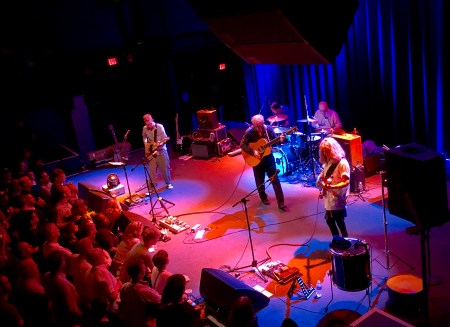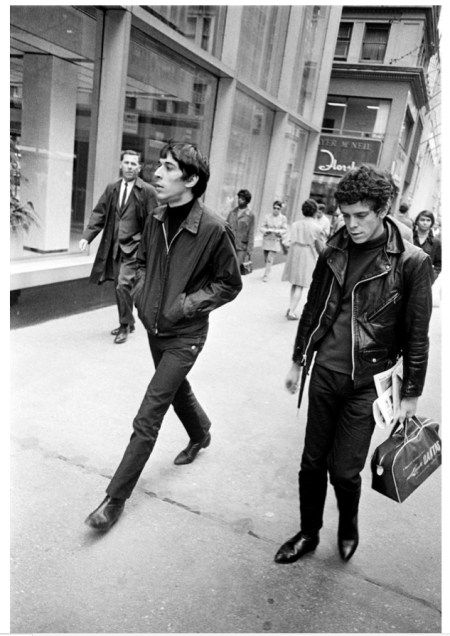The good news is that the New York Times assigned the obit to someone other than Jon Pareles, so we didn’t have to read sentences like, “Many of the group’s themes — among them love, sexual deviance, alienation, addiction, joy and spiritual transfiguration — stayed in Mr. Reed’s work through his long run of solo recordings.” Oh wait, actually, we did have to read that in the Times, because Pareles still sets the tone there, and Ben Ratliff — no matter what his natural writing style was before he got there, has to play the tune called by Jonny. But still, out of the long day and evening, as more writers weighed in, we got to read the good and the bad.
Jacob Weisberg, editor of Slate, revealed he doesn’t know very much about rock’n’roll when he tweeted, “Little known fact: his early teacher was the late Delmore Schwartz.” Uh, no. If you listen to rock’n’roll, you know that about as well as you know that 15 minutes served up to Geico returns 15 percent savings on your auto insurance; it is like knowing that Jimi Hendrix played guitar left handed. It is a threshold-level fact, and if you didn’t know it, for God’s sake, shut up. And a special dunce cap is reserved for any and all who summarized Lou’s work with a reference to “Walk On The Wild Side,” his least consequential song, even if it was a novelty hit.
But still, there were some really good things posted. Let’s give credit where it is due: the initial Rolling Stone announcement at 1:15 PM was solid.
By early evening, we had a typically terrific remembrance from The New Yorker‘s Sasha Frere-Jones. (Thank Heaven for Sasha, who almost always gets it right.)
Later in the evening, of course, we heard from Christgau, Chairman Emeritus of the department, the dean of them all. And his piece was hilarious, recalling the time that Lou had denounced him from the stage as a “toe fucker.”
Now, we weren’t at that particular show by Lou, but we were alive and well and attending his concerts during that great Street Hassle phase in the late ’70s, when he was caustic and outrageous and sang songs like “I Wanna Be Black,” whose lyrics can’t be printed in a family blog.
Our last word on Lou here will state four things.
First, how grateful we were to be old enough to remember the Velvet Underground, not as historical antecedent, but as a real band, even if our particular entry point was Loaded. Even if weren’t wise to the kismet of The Velvet Underground and Nico being released on the same day as Sgt. Pepper’s Lonely Hearts Club Band, our teenage playlist included “Train Comes Around The Bend,” and we were hip to Mott The Hoople kicking off All The Young Dudes with “Sweet Jane”, creating that nexus between Lou Reed, David Bowie, and Iggy Pop — which would become so important to us in our late teens — in real time. We can remember seeing that first Velvets album, with its peel off banana sticker, in the bins of a small-town record store, and passing on it to buy, with our allowance, Your Saving Grace. But still, The Velvets lived for us, even if our obsession with them didn’t kick in until around 1977.
A-and let us proclaim how grateful we were to have been able to see Lou play with his greatest band from the early 1980s — Fernando Saunders on bass, Fred Maher on drums, and of course, Robert Quine on guitar. While today it’s quite worthwhile to listen to all the sonically deficient but historically vital Velvets live recordings, including the tapes that Quine recorded when he was a law student following the VU around like some prehistoric Deadhead — and you should go right now to find Velvet Underground Live 1969, which was recorded before about 12 people in a club in Dallas, yes, Dallas. But if you really want to listen to Lou live, and in his purest form, get Live In Italy. It has both an excellent compendium of Velvets songs and songs from The Blue Mask and Legendary Hearts, his two greatest albums, which he spent the early ’80s touring to support.
And to put it simply, and sincerely, since many have declared their favorite Lou song, let us quietly declare that ours was “Rooftop Garden,” from Legendary Hearts, which perfectly conveys two of Lou’s greatest, and most benign, influences: folk music and Brill Building pop couplets.
Finally, Lou Reed’s passing seems in some ways like a dress rehearsal for that inevitable day when Dylan dies. The floodgates of foolishness will open on that sad day in the future, as all the wrong songs get quoted on Twitter, and it will take a few authoritative voices to weigh in and set the genuine historical record straight — Mikal Gilmore, Jonathan Cott, Jann Wenner. Lou Reed’s death yesterday, though, was the first of the real giants of our shared rock’n’roll past dying at a ripe old age, which 71 really is. This is not like John Lennon being assassinated or the 27-year old Hendrix succumbing to pills or even the 50-year old Joe Strummer dying of a heart attack. This was a precursor to all the obits yet to come, of Paul McCartney and Ringo Starr, and Mick and Keith and Charlie. And so long as we have voices like Sasha Frere-Jones, and we pray, a nonagenarian Bob Christgau to wash away the idiocy of what we’ve grown to expect from the Pareles-era Times and Twitter, everything’s going to be alright. We’re going to have a real good time together, remembering the greats for what they were, and what they meant to us.




